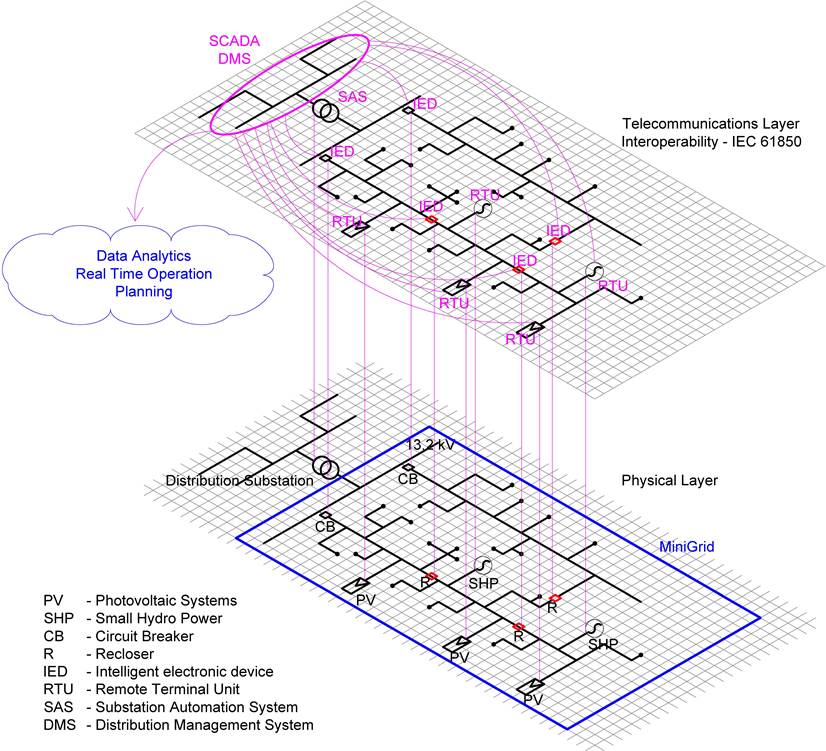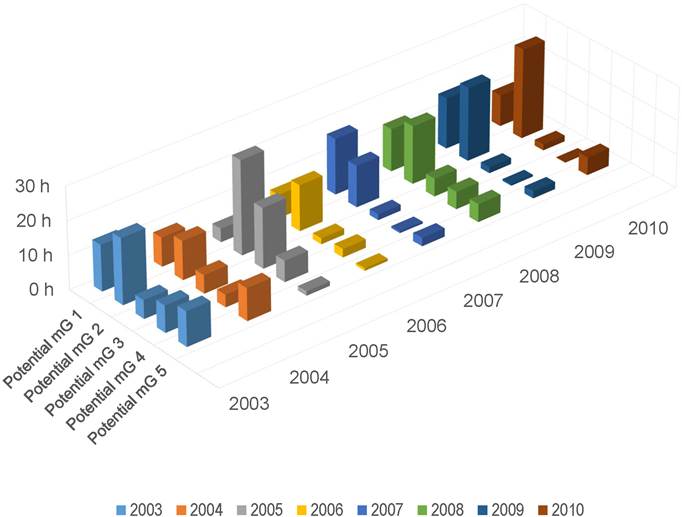1. INTRODUCTION
Ancillary services are grid-support services required by electrical power systems (transmission or distribution system operators; TSO/DSO) to maintain power security, stability and quality [1]. These support services have typically been supplied by large generation plants and controlled by transmission system operators. However, the massive presence of Distributed Generation (DG) connected at the level of distribution networks enables the operators of these systems to provide ancillary services. Several authors around the world have studied ancillary services from distribution systems, for instance: technical capabilities of the network to provide voltage control, reactive power compensation [2], asymmetric reduction, harmonic mitigation [3], frequency control [4], [5], congestion management, optimization of system losses, black start, and an improvement in power quality [6].
In Latin America, the installation of DG has been increasing within the energy matrix, mainly, thanks to state policies that have successfully leveraged such growth [7]. In Colombia, Law 1715 of 2014 aims to promote the development and use of non-conventional sources of energy, mainly renewable, as a necessary means for sustainable economic development and the reduction of greenhouse gas emissions. In addition, this Act promotes the efficient management of energy, which includes both energy efficiency and demand response (Law 1715; Article 1, 2014) [8]. In Colombia, the supply of electrical energy is a key service for the economic and social growth of communities that enables to reduce the huge social inequality between the populations in the national interconnected system and the non-interconnected areas [8]. Several sectors of the electric market expect a considerable installation of DG in the electrical distribution system, and a DG penetration greater than 30 or 40% results in issues for the operation and planning of electrical systems [9]. In fact, massive installation without an adequate control and planning system could have negative side effects that would force network operators to incur cost overruns, as they affect the indices of security, reliability and security of the supply [10].
There is a new paradigm in the operation of electrical systems that consists of changing from passive to active distribution systems, where new planning schemes are required and the possibility of supplying ancillary services from distributed generation has emerged. Among the ancillary services that have been studied is Islanded Operation Capability (IOC), defined as the ability of a fraction of the system to operate autonomously in the event of a failure or maintenance. Furthermore, IOC’s capacity to maintain the required standards of quality, safety, reliability and resilience in the energy supply has been examined. IOC’s ancillary service is closely related to the operation of systems by microgrids, also called mini-grids (mG), in the case of islanded villages or small remote places. However, it is necessary to make a distinction between these two concepts. The operation of mG deals with the ability of a fraction of the distribution, sub-transmission or transmission system to be isolated from the electrical power system in the event of a local failure, maintenance event or general disconnection [11]. IOC’s ancillary service is associated with the ability of the DG to produce electricity in both modes, interconnected or isolated (islanded) from the distribution system. In case of a general outage (blackout), the service restoration process starts quickly, using the electrical islands that were formed as a reference, which will serve to start large generation plants [12]. Hence, a generation capacity above 5 MW is recommended for electrical islands that contribute to the restoration process (in accordance with requirements by the TSO); otherwise, many signals from various islands would be generated, which would hamper the resynchronization and processing of control signals [1].
A intentional islanded system is used during emergency situations of an Electrical Power System (EPS) as a mechanism to prevent incidental disconnections and voltage collapses and increase the reliability of the supply [13]. Enabling the electrical distribution system to be operated by mG implies the uncertainty of obtaining all the theoretical advantages that are attributed to this type of operation, aside from establishing, in detail, the technological changes required for mG operation in a study case. This paper determines the technological changes necessary to enable the operation of an existing electrical distribution system by a mG. Also, the possibility of enabling IOC ancillary service in the Colombian electricity market is studied.
Section 2 describes the research method. Section 3 draws a conceptual comparison between unintentional and intentional islanding. Section 4 details a technical analysis for the implementation of IOC ancillary service. Section 5 explains a proposal for the implementation of IOC ancillary service in Colombia. Finally, Section 6 presents the conclusions and recommendations for the implementation of IOC ancillary service.
2. METHOD
The design of a competitive scheme for a technical support service such as IOC ancillary service requires a method to analyze technical (operational requirements) and economic variables (investment) in order to determine a regulatory framework in accordance with the conditions and the degree of technological development of the place where the service will be implemented. To address this problem, Systemic Thinking is proposed as a comprehensive methodology that analyzes the whole problem, each part, and the relations between events and parts. This methodology was developed in the nineteen sixties and it has been used in research related to electric power in regulated environments (e.g. Ford, 1997) as well as in deregulated systems (e.g. Bunn & Larsen, 1992, 1994; Ford, 1999; Kadoya, 2005; Zuluaga & Dyner 2007; Carvajal, 2013; Arango, 2017).
Sterman (2000) asserts that Systemic Thinking (ST) is a methodology suitable for policy studies or the design of regulatory frameworks in liberalized electricity markets. The application of ST in academic fields of different disciplines establishes a conceptual framework that helps to make the first approach to identifying the causality of problems (Senge 1990). It is a method related to using the control theory to solve management and design problems, with an emphasis on information and delays. In addition, ST is a simulation method that creates management models where different alternative solutions can be evaluated (Aracil, 1983) to identify the one that can work best in the evaluated system. In the study of ancillary services, ST has been explored to determine appropriate regulatory scenarios to remunerate autonomous start-up services (Carvajal et al., 2013) and stress control (Carvajal et al., 2012).
ST enabled to identify two key elements in the proposal to calculate the remuneration of IOC ancillary service. The first one is the technical analysis of the area where IOC is to be implemented as an ancillary service. In accordance with the identification of the problem described in the previous section, this technical analysis must include a diagnosis of the current state of the distribution system’s automation. The second key element is that, in a market-based scheme of IOC ancillary service, investments are the main drivers (Sioshansi, 2016). After quantifying the investment grade based on the technological needs of the distribution system to be improved, the regulatory conditions of the Electric Power System (EPS) should be discussed, since the economic sustainability of the ancillary service depends on the coherence between existing regulatory policies and proposed regulatory conditions to remunerate the IOC service. The following sections explain the technical and economic conditions and regulatory proposals that would enable the successful implementation of IOC ancillary service in the Colombian EPS.
3. UNINTENTIONAL VS INTENTIONAL ISLANDING
Islanding is a condition where a local generator intentionally or unintentionally supplies energy to a segment of local load or distribution system. An unexpected (sudden) operation of the island poses risks to repair crews in the distribution networks and may cause damage to electrical equipment because voltage and frequency levels are not guaranteed. Operation by intentional islands in electrical distribution systems is provided as an alternative in the operation; it is characterized by the aggregation of loads and sources capable of operating with or without a larger electric grid while providing continuous power to final consumers. Depending on the configuration, power flows only within the mG or can be exported to a utility.
The main objectives of a mG are to maximize the operation of Distributed Energy resources through the integration of communications and, simultaneously, to significantly increase the efficiency of the system, which leads to a reduction in operation costs [14]. Several authors have developed works that describe the benefits and issues of mG operation. A description of the main research associated to this type of operation is provided below:
Efficiency of distribution systems: The efficiency of a system is related to its ability to deliver a bigger benefit for the same work; therefore, if the current electrical system is a mG connected with network sources, system losses and congestion on transmission networks are reduced [15]. Likewise, by means of a mG, the flexibility of the system can be increased, thus enabling users to participate in active demand programs [10].
Flexibility of distribution systems: An increase in the flexibility of a distribution system improves its reliability, as well as the safe integration of a network. To achieve such increase in flexibility, several authors propose smart mG control schemes [16], [17].
Protection coordination: The presence of DG in a distribution system can produce a significant impact on the operation and coordination of protection [18]. A failure is produced by the closest generation source; therefore, current fault tends to increase in presence of DG. In addition, when the system is operating in isolation or as a mG, the short-circuit currents vary enormously, which suggests that new studies should be conducted on the coordination of protection when the mG operates in isolation.
Operational security: It has been shown that a mG can be used as a support mechanism that can prevent blackouts [19], [20]. Also, grid security increases due to the fact that the generation by the mG is small-scale. Conversely, many large-capacity projects are experiencing construction delays due to their environmental impact, which could result a security problem for the supply of a particular country.
Loss of synchronism: The loss of synchronism is a very common problem during the formation of islands and re-synchronization with the system. Many utilities use reclosers to improve the reliability of their supply; when a fault occurs, these reclosers open the circuit for several seconds (according to the criteria of the system operator) and, afterwards, they close again. To conduct this operation in presence of DERs, the phase angle of the network and the system may not be synchronized, which can strain the rotor of the DG sources and cause problems in the loads [18].
Service quality and reliability: mGs are used as mechanisms that help mitigate voltage sags and swells, reduce unwanted harmonics and Total Harmonic Distortion (THD) [21]. Furthermore, it is possible to increase the reliability for users within the mG [22], [23]. Some authors consider the mG service as premium, which can be accessed by critical or special loads that require a service with superior reliability for the distribution system.
The reliability of the electricity service is related to the continuity of supply, which is established through indices that have been standardized in accordance with IEEE Std 1366 - 2012 [24]. The SAIDI (System Average Interruption Duration Index) is a general index that calculates continuity and measures how often the average customer experiences a sustained interruption over a predefined period. Mathematically, this is shown in (1). Besides, the SAIFI (System Average Interruption Frequency Index) indicates the total duration of interruptions for the average customer during a predefined period, commonly measured in minutes or hours of interruption. Mathematically, this is shown in (3).
To calculate the SAIDI index, the following formula can be used (2):
Where r i is the restoration time for each interruption event; N i , the number of interrupted customers for each sustained interruption event during the reporting period; and N T , the total number of customers served in the area.
Additionally, the SAIFI can be mathematically represented as:
Where CI are interrupted customers. Table 1 shows the mean values of continuity indices of distribution systems over the last decade in different countries in the world. These data are representative values of scheduled and unscheduled outages. Table 1 shows the unavailability indices at the global level for distribution systems; such values are an estimate given the complexity of the information and the amount of distribution.
3.1 Quantification of service reliability to implement the ancillary service of Island Operation Capability
The quantitative reliability evaluation of a distribution system can be divided into two: measuring past performance and predicting future performance [30]. Moreover, the techniques for a radial distribution system are based on failure-mode analysis that includes considerations of all the realistic failure and restoration processes [30]. The comparison between a normal distribution system with distributed generation and the same distribution system after the implementation of island operation is drawn by taking a typical radial system that provides the service to 900 users, as shown in Fig. 1. To perform such quantification, the method by Allan and Billinton for typical radial distribution systems [30] is adopted.
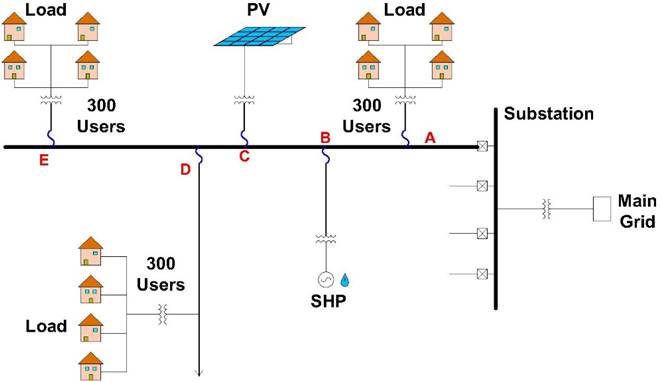
Source: Authors.
Fig. 1 Faults simulation on points A, B and C in a typical distribution system with distributed generation.
The two main reliability indices, SAIDI and SAIFI, are used to quantify the reliability of the distribution system [24] by means of three rating functions: contingency analysis, generation reliability (assessment of the capacity of the generation to cover the total demand of the system) and network reliability (assessment of statistical data of interruption by loads, individual lines and substations of the network).
In this case, we want to determine the reliability of the network. Therefore, the Monte Carlo method, which enables to calculate the system failure frequency, should be employed. Moreover, 300-meter feeders are assumed between each point in the system (A, B and C).
Table 2 shows that the island operation considerably reduces energy not supplied and energy not generated. The non-supplied energy has a reduction close to 50% when the operation by intentional islands is enabled in the electrical distribution system under study.
Table 2 Summary of the reliability of the energy that enables the operation by an islanded mini-network.
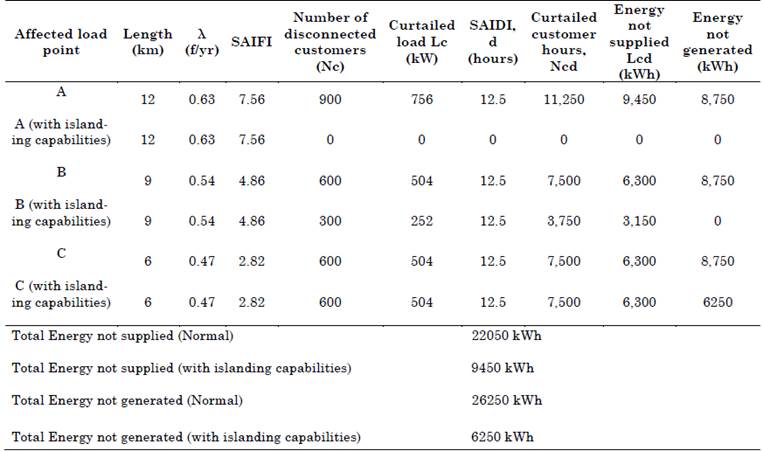
Source: Authors.
This reduction depends on the availability and percentage of installation of the Distributed Energy Resources, the energy demand at the moment of the simulated faults, and the duration of faults.
The energy not generated by the Distributed Energy Resources, shown in Fig. 1, has a reduction close to 70% due to the activation of the operation by islands. Non-generated energy in general occurs when there are faults in the electrical distribution systems and, because said systems are radial, the generating units must be turned off until the service is restored. Thus, the energy not generated depends on the reliability of the distribution system to which it is connected and, in a smaller percentage, on routine maintenance. The operation by intentional islands requires technical support to maintain the stability and continuity of the supply in distribution networks. The next section explains the technical analysis for the implementation of IOC ancillary service.
4. TECHNICAL ANALYSIS FOR THE IMPLEMENTATION OF IOC ANCILLARY SERVICE
This technical analysis begins with a description of the technical changes required to enable island operation in an existing distribution system. To determine those changes, prior planning is necessary to provide operation alternatives and automation levels, which would achieve different degrees of flexibility and reliability in the provision of the service. The first subsystem is related to the physical infrastructure, i.e., the installation and adequacy of protection, control and management devices. Then, there is the telecommunications subsystem, which refers to the communications networks operation, i.e., RTU (Remote Terminal Unit), IED (Intelligent Electronic Device), SCADA (Supervisory Control and Data Acquisition), and DMS (Distribution Management System). The integration of these components is achieved under interoperability standard IEC 61850. Finally, the third subsystem is related to data management, including data analytics, which allows an optimal integration and an efficient island operation of these three subsystems.
Electrical Subsystem: Table 3 shows a description of the main elements required in a conventional distribution system to enable mG operation. The components may vary according to the type and quantity of distributed energy resources installed in the distribution network. However, these elements are needed to operate in the form of a recommended island under IEEE Std 1547.4 - 2011 [31].
Table 3. Descriptionof main operation elements by mG in existing distribution systems.
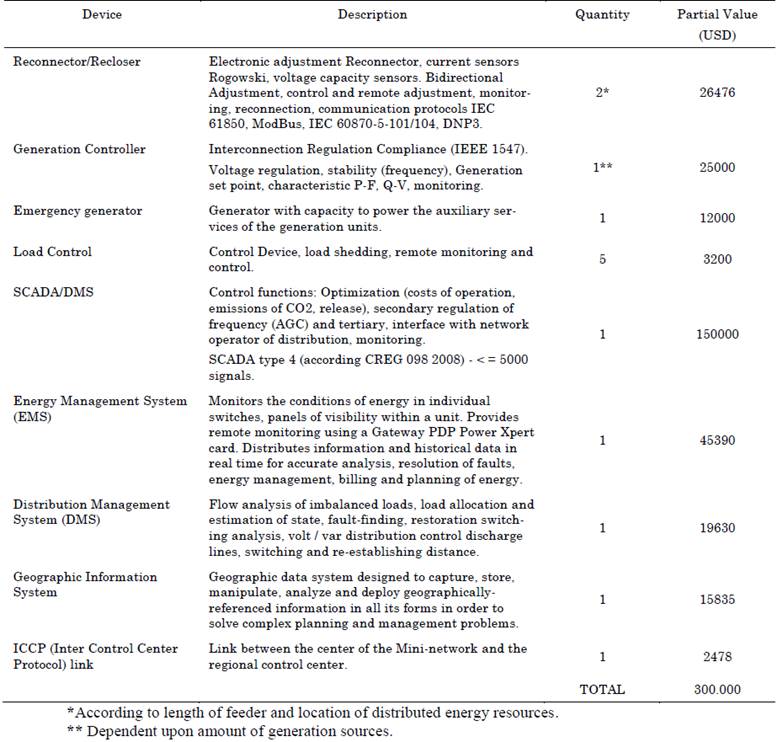
Source: Authors.
Telecommunications subsystem: IEC standard 61850 is about communications systems of intelligent networks, and it offers models, definitions and operation functions [32]. The telecommunications subsystem integrates the signals of protection and control automation in a SCADA system. These functions are dependent on a pre-set of the proprietary architecture of the distribution system, substation, nodes and devices that control the automatic system of the substation (SAS) [33]. Depending on the location of the distribution system and the degree of reliability of the formation of the island, a unique infrastructure is required for the telecommunications system. However, the analysis is performed by assuming that it will use a conventional communications system for commercial operators.
Analytical Data Subsystem: The analysis of the information submitted by the electrical systems leads to distribution planning and effective operation [34], both expansion and decision-making in real-time, self-healing, and an increase in the accuracy of small generation optimal location and demand forecasting [35]. Information on the demand is key knowledge for the implementation of differential rates and load management schemes known as Demand Management Programs (DMPs).
The success of the implementation of the DMP depends on a design based on the complete analysis of information related to the characterization, needs and desires of customers. The design of a DMP is a convenient cyclical process of continuous feedback through strategies that initially cover education and training of people with knowledge of energy efficiency and the importance of this issue, not only regarding reducing electricity consumption, but also the relationship with environmental, political, and social rights aspects.
Once the elements required to enable islanded operation in a conventional distribution system have been determined, it is necessary to estimate and quantify the components and costs associated with such implementation and, subsequently, consider the benefits and the proposals for the remuneration of the ancillary service. Table 3 shows a description of the elements to enable the island operation in an existing distribution system. The costs calculated in Fig.2 include the value of the equipment, engineering, commissioning, administration, inspection, and the financial costs set out in Colombian Resolution CREG 2008/097.
The technical infrastructure requirements necessary for island operation were determined in Table 3. Additionally, a technical analysis of IOC ancillary service should be carried out to create a reference for the conceptual framework of standard IEEE Std 1547.7-2013. The latter will allow to determine any adverse conditions in the operation, the security and reliability of the electrical system of distribution that has been preliminarily selected to enable IOC ancillary service.
The particular impacts depend on the type of primary source to install, installed capacity of DER, and the installation place, i.e., the particular conditions of the distribution system [36]. However, the standard has a list of preliminary conditions to evaluate the main aspects of the network connection in a distribution system, which are shown in Table 3.
Once the technical requirements and the basic prefeasibility and feasibility studies to operate a distribution system have been identified, a comprehensive analysis is required for the implementation of IOC ancillary service in Colombia. This analysis integrates the current behavior of technical, regulatory and economic variables. The next section describes current distribution grids and provides a partial update of the indicators related to Continuity of Supply (CoS) in Colombia.
5. PROPOSAL FOR THE IMPLEMENTATION OF IOC ANCILLARY SERVICE IN COLOMBIA
To carry out the proposed implementation of the IOC ancillary service, a general outlook of the current state of the electric distribution systems in Colombia and the regulatory conditions that allow to identify the challenges for said implementation should be presented. The general characteristics of electric distribution systems in Colombia and the reliability indices of five potential mGs found in different regions in the country are shown below. Finally, a regulatory proposal based on IOC ancillary service in Colombia is outlined.
5.1 Outline of Colombian Distribution Networks
The Colombian electrical distribution systems consist of more than 470,000 km of network and more than 500,000 distribution transformers [29]. With regard to the reliability of electrical distribution systems, there is a difference between network operators in different regions and voltage levels. Therefore, calculating general average reliability indicators can result in great uncertainties. Thus, for voltages below 1kV, the average interruption in Colombian distribution systems ranges between 13 and 18 hours per year. For voltages between 36 kV and 1 kV, the average interruptions are between 10 and 15 hours [29]. Accordingly, efforts should be made to increase the reliability of the electricity supply.
Figures 3 and 4 show the behavior of the unavailability indices of some feeders in Colombian distribution systems with distributed generation. These five feeders have the potential to operate in intentional islands or mGs. Each feeder is numbered based on its location in Colombia, i.e., potential mG1 and mG2 are located in the central region; potential mG3, in the Pacific region; and potential mG4 and mG5, in the Caribbean region.
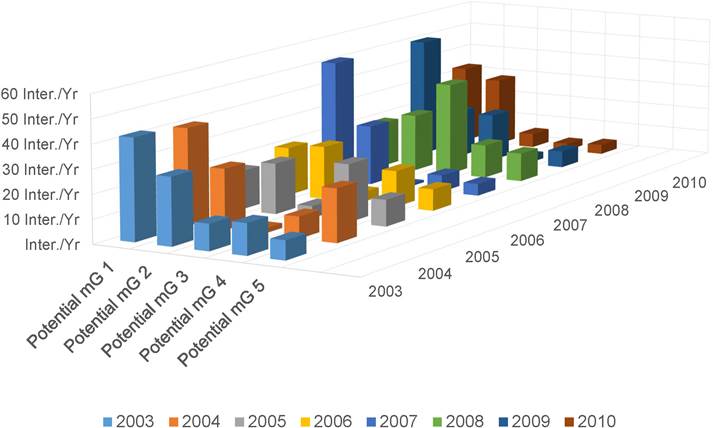
Source: Authors.
Fig. 4 SAIFI indices for distribution feeders with feasibility for DG installation.
The reliability indices shown in Figs. 3 and 4 indicate that five feeders in Colombian electrical distribution systems have a lower reliability than all the countries in Table 1. The low reliability of electrical distribution systems in Colombia is due to the lack of regulations signals that encourage an increase in reliability. Thus, investments in new expansions and repositions of the system are made to satisfy primary needs. However, improving the reliability of the system is not the main objective.
Currently, a methodology for compensating operators of the distribution system when they have made investments to increase the efficiency and reliability of their distribution systems is being discussed. This could be a first step to enable the operation by mG in the electrical distribution systems in Colombia. Such methodology is regulated by resolution CREG 176-2016 [37]. Therefore, IOC is presented as an ancillary service that is starting to be used in different countries and whose benefits have been widely studied. Hence, it becomes necessary to promote regulatory policies that allow the implementation of such service. A proposal for the implementation of IOC ancillary service in Colombia is presented below.
5.2 Proposal for the implementation of IOC Ancillary Service in Colombia
The implementation of the IOC ancillary service in an electric market is an activity that involves different agents of the supply chain, which makes it necessary to establish the particular interests of each stakeholder and, thus, select an optimal option between different alternatives. In addition, the IOC ancillary service and the ancillary services for voltage control, reactive power supply and black start service are subject to compensation. The payment should be annual because it is not possible to implement auctions (the supply of these ancillary services depends on the location of the DERs). Therefore, to calculate a compensation value of the IOC ancillary service, it is necessary to establish the benefits in terms of reliability, safety, efficiency, flexibility and resilience of an electrical system. Consequently, since the determination and quantification of these benefits may experience difficulties due to the lack of information and knowledge about the actual operation of an electric distribution system, the risks involved in island operation and the costs of implementing an IOC ancillary service should be evaluated. Fig. 5 shows a regulation proposal for the implementation of the IOC ancillary service; it is composed of four stages that relate to different activities.
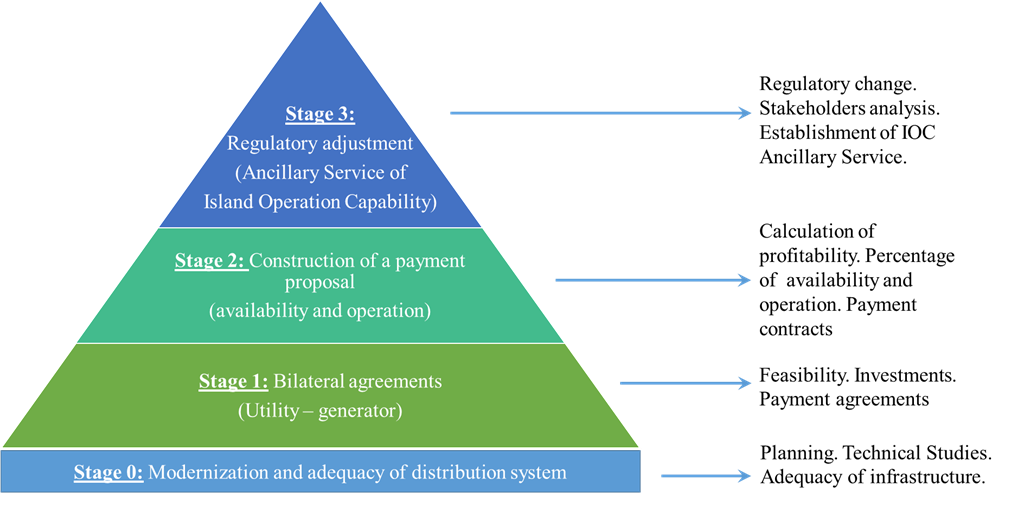
Source: Authors.
Fig. 5 Proposed regulation of the implementation of the Ancillary Service of Island Operation Capability.
Stage 1 proposes the creation of bilateral agreements between the promoters of generation projects and local network operators. These bilateral agreements have the prefeasibility and feasibility of intentional island operation in terms of the benefit/cost ratio as a reference, i.e., the estimate of technical and economic benefits for different stakeholders (generator, operator, and end user), capex required for intentional island operation, and agreements for the payment of the IOC ancillary service based on the results of the feasibility study.
In Colombia, CREG Resolution 024-2016, which establishes a methodology for the remuneration of electricity distribution, is currently under discussion. This resolution would allow to make investments in distribution systems that seek to enable intentional island operation and recover said investments thanks to improvements in efficiency and reliability. Finally, agents that promote small-scale generation projects can receive compensations for providing the IOC ancillary service. This compensation must be related to the value of the additional investment that generating agents pay when they implement intentional island operation.
Once the costs have been identified and the general operation of intentional islands in electrical distribution systems in Colombia has been defined, the second stage is next. Stage 2 involves the construction of a payment proposal, which is related to the hours and percentages of annual operation and availability of the IOC ancillary service. To obtain an adequate payment proposal, the profitability and benefits associated with intentional island operation should be calculated. Therefore, it is necessary to have the information and knowledge that has been obtained from the first stage. In addition, the operating conditions of the electrical distribution systems, as well as the impact of the Distributed Energy Resources installed are different. Consequently, a payment proposal for the IOC ancillary service must integrate meteorological, social, environmental, technical and economic factors that are adapted to each distribution grid. Finally, the payment proposals of the IOC ancillary service should be periodically evaluated and adjustments should be made if necessary.
As a final step of the regulatory proposal for the implementation of the IOC ancillary service, a regulatory adjustment of the Colombian electricity market is necessary. In Colombia, the provision of ancillary services is regulated under CREG 025/1995 as part of the technical requirements for the connection of generation to the national transmission system. In particular, only the primary frequency control (mandatory and penalties for non-compliance) and the secondary frequency control (commercial responsibility between generators) are regulated. Thus, it is necessary to adjust the current regulation of ancillary services, determine the overall benefits of implementing the IOC ancillary service and establish the specific stakeholders to implement said service in Colombia.
The development and incorporation of the IOC ancillary service will require changes in the technological platform for short-term market programming, clearance and settlement, as well as an increase in the administrative costs of the system operator. Such costs are related to the need to increase the personnel and implement procedures for managing information, allocation, calculating and monitoring the performance of these services.
6. CONCLUSIONS
The electrical distribution systems in Colombia have lower reliability indices than in developed countries. In addition, the Colombian regulation does not provide clear signals for the operators of the distribution systems to make investments in infrastructure in order to increase the reliability. Since 2014, there has been an increase in the installation of DG due to the approval of a law that encourages the installation of generation from renewable resources.
Distribution feeders with DER have the potential to increase reliability by enabling island operation. However, it is necessary to make investments in distribution networks, equipment and devices associated with enabling the island operation of DERs. This investment can be made through laws like CREG 176-2016 [37] that promote the enhancement of the reliability and efficiency in electrical distribution systems.
This paper proposes a planning process to implement the islanded operation of some areas of the distribution grid through the combination of three layers: electrical infrastructure, communications and data analysis. This enables the viability of a flexible operation of the distribution systems. In addition, there is a proposal to standardize technical requirements for the installation of DERs, establish scenarios for the remuneration of new assets, and encourage flexible operation in distribution systems. All of these strategies aim to achieve the implementation of the IOC ancillary service in the Colombian electrical system. As a result, the distribution system could improve its reliability indicators of security of supply in the short term.

















